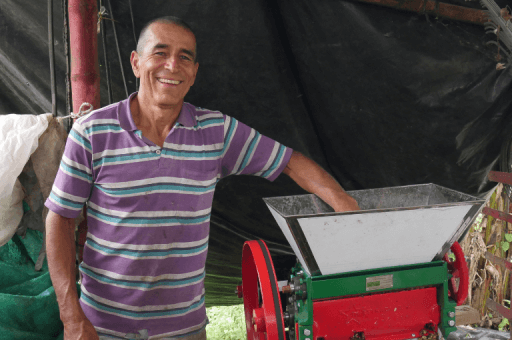Coffee, Birds, and Forests in the Colombian Andes

It's a chilly November morning on Marino Cifuentes's coffee farm in the Central Andean region of Caldas, Colombia. His home is one of our stops on a three-day tour of coffee farms that are being transformed into places where birds can thrive. Rocío Espinosa and Andrés López are leading the tour – two agroforestry and bird conservation experts who are partnering with the farmers to improve habitat for birds.
“This small farm serves as habitat for migratory birds, sloths, armadillos, and coati,” said Cifuentes, who has planted dozens of native trees, reduced water use, and eliminated pesticides from his farm. “It's important to help migratory birds in their journey, ensure that when they come here for their stay, they can find fruit trees, insects, food.”

More than 70 species of migratory birds travel from North America to the Caldas region to spend the winter, such as the Yellow-billed Cuckoo and Red-eyed Vireo. Upon arrival, these birds often encounter habitats that have been fragmented and degraded by tree felling for wood production, agriculture, and urbanization. These degraded landscapes are also less hospitable for local people and less resilient given our changing climate — more mud slides and erosion, less shade and higher daytime temperatures.
Despite these challenges, farmers like Cifuentes are working to restore the landscape by collaborating with Paisajes Sostenibles (PaSos), a multi-partner sustainability initiative supported by American Bird Conservancy (ABC) and led by the local nonprofit Corporación VivoCuenca. The project aims to restore degraded working lands, increase habitat connectivity, and reduce the environmental impact of coffee production, all while maintaining productivity for farmers.
“The Central Andes is a very important area for migratory birds,” said Eliana Fierro-Calderón, ABC's International Project Officer. “We started working with these partners that know the reality in the field and are connected to key actors in the region."

In addition to American Bird Conservancy (ABC) and VivoCuenca, the initiative also counts the support of the Comité Departamental de Cafeteros de Caldas (Caldas Coffee Committee), which represents over 30,000 families in the coffee sector. Other partners include the Fundación Ecológica Cafetera, which focuses on making coffee production more sustainable, and CHEC, a hydroelectric company that is working to conserve the rivers that serve as a source of electricity for the region.
“This is a very heterogeneous landscape,” said coordinator Espinosa. “We have to understand the motivations of various actors, the dynamics of the institutions, so that we can encourage more environmental decision making that benefits migratory birds and the different actors in the region.”
A Changing Landscape
The initiative is being implemented within the framework of ABC's BirdScapes, large geographies strategically located to ensure priority migratory bird species have the habitat they require at all stages of their life cycles.
The Central Andes BirdScape is the winter home of three species that the PaSos efforts target: the Cerulean, Golden-winged, and Canada Warblers. These three reinitas (the Spanish name for the warbler family) have lost half of their populations in the past 50 years, and the Golden-winged Warbler is on track to lose another 50% in the next 50 years.
In the Andes, these species inhabit areas from 3,300 to 9,800 feet (1,000 to 3,000 meters) elevation, which coincides with the coffee-growing zone, explained agroforestry expert Andrés López. “This is an area where historically, one of its main sources of income has been coffee. [Coffee] has shaped its landscape, its architecture, its customs,” he said.

Today, approximately 350,000 acres are dedicated to coffee in the Caldas region, part of Colombia's eje cafetero, or coffee axis. Almost 95 percent of producers are small-scale growers with farms of about two acres – small family operations like Cifuentes's. The rest are farms of over 100 acres, such as Hacienda Venecia and Hacienda La Mesa, two other stops on our coffee tour.
Decades ago, coffee production was carried out under the shade of trees in most of Colombia, but intensified demand, decreasing coffee prices, and competition in the 1960s led to the disappearance of that more sustainable practice. Farmers abandoned the traditional way in favor of higher-yielding sun-grown production and increased their use of agrochemicals, resulting in degraded habitats.
While many bird-friendly coffee projects, such as the Red Siskin Initiative in Venezuela and UCA San Juan's in Nigaragua, focus on shade-grown coffee, in this rainy zone in Colombia with few hours of sunlight, growing under shade would be incompatible with sustainable livelihoods.
“The solution [around Caldas, Colombia] is not necessarily to go back to growing under shade, because that could cause up to a 40 percent decrease in production,” López said. “But we can find spaces to plant native trees or plants and create corridors within the farms that connect them with fragmented forests.”
What are farmers doing to create these corridors, then? Learn about the strategies that PaSos is employing that help birds, other wildlife, and people in Part 2 of Erica's report.



















































